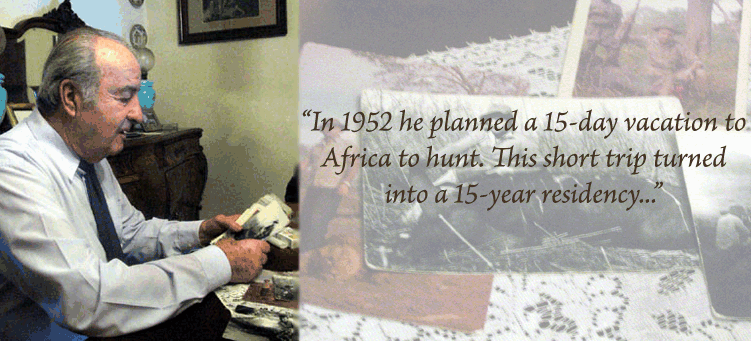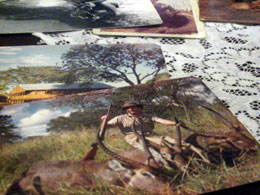 |
 |
| |
| At almost 80 years old, Giorgio
Rossi of Cagli vividly recalls the summer of 1953 when for
21 days, he guided the Nobel-prize winning novelist Ernest
Hemingway through the jungles of Mozambique on a safari. Throughout
the journey, Hemingway kept a journal, published almost 40
years after his death as the novel, True at First Light.
Rossi remembers asking Hemingway what it was he was writing
late at night in his room, to which he responded, “My
impressions on hunting.”Rossi, whose parents are native
of Cagli, spent 15 years in Mozambique as a “white hunter.”
He nostalgically spreads black and white photos of himself
holding a rifle, proudly posed over dead lions, snakes and
zebra.
Rossi was born in Bengasi, Libya, in 1925. His father’s
position in the army caused the family to move frequently,
and three years after his birth they moved back to Italy.
Rossi spent the next 27 years moving around Italy and working
in the medical field.
In 1952 he planned a 15-day vacation to Africa to hunt. This
short trip turned into a 15-year residency in Beyra, Mozambique,
where he became licensed as a “white hunter.”
|

|
|
 |
As such, he guided tourists on safaris. He lived in the jungle
in a wooden house on stilts as part of a four-person team consisting
of two white hunters and two gun bearers. The white hunters showed
the clients where the game was. The gun bearers were natives who
watched out for the safety of the clients if an animal should come
too close.
In 1953 Hemingway arrived at Rossi’s campsite for a 21-day
safari, 20 years after his first safari to Kenya and Tanzania. That
safari resulted in the travel essay, “The Green Hills of Africa”,
as well as the noted short stories, “The Short Happy Life
of Francis Macomber,” and “The Snows of Kilimanjaro.” |
 |
Rossi recalls that Hemingway was a skilled hunter, unlike most
clients. He knew how to handle a gun. He was passionate about hunting
buffalo, the most dangerous animal, second to the leopard.
Buffalo roar like lions and charge like bulls. However, instead
of charging with their heads down, they keep their faces turned
toward their enemy while baring their large set of teeth, Rossi
said.
Taking down a buffalo sometimes takes up to five bullets. For this
reason, is was not uncommon for these animals to take a shot without
falling. When this happened, the hunter had to follow the wounded
animal’s blood trail in order to finish it off. |
|
The gun bearers were especially
skilled in tracking blood traces on leaves, Rossi said. From these
traces, they were able to tell if the animal was going to die or
not, which was crucial in making the decision weather or not to
follow it.
Rossi said that Hemingway trusted the native gun bearers more then
the white hunters for this reason. It was not uncommon for him to
follow their instincts rather than the white hunter’s instructions.
In the summer, when the grass was dry, the native’s trained
ears heard every small movement in the bushes.
Since returning from Africa in 1962, Rossi has told his stories
from Africa many times. However, his living room gives no clues
that he was once a serious hunter. No animal heads or guns hang
from the wall; no medals or plaques are displayed on the shelves.
Rossi said having these things around would be too painful a reminder
of the life he left behind in Africa. For him, it was more important
to live in Italy and raise his two sons.
Even though Rossi said he will never return to the land he loves,
he will always have the memories to remind him of experiences very
few can match.
|
 |
Web Design by:
Christina Verdeschi
|
Story by:
Alexis Roth
|
Video by:
Nicole Luccarelli |
Photo by:
Sean Fitzgerald |
|
|








